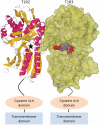SuperSweet--a resource on natural and artificial sweetening agents
- PMID: 20952410
- PMCID: PMC3013782
- DOI: 10.1093/nar/gkq917
SuperSweet--a resource on natural and artificial sweetening agents
Abstract
A vast number of sweet tasting molecules are known, encompassing small compounds, carbohydrates, d-amino acids and large proteins. Carbohydrates play a particularly big role in human diet. The replacement of sugars in food with artificial sweeteners is common and is a general approach to prevent cavities, obesity and associated diseases such as diabetes and hyperlipidemia. Knowledge about the molecular basis of taste may reveal new strategies to overcome diet-induced diseases. In this context, the design of safe, low-calorie sweeteners is particularly important. Here, we provide a comprehensive collection of carbohydrates, artificial sweeteners and other sweet tasting agents like proteins and peptides. Additionally, structural information and properties such as number of calories, therapeutic annotations and a sweetness-index are stored in SuperSweet. Currently, the database consists of more than 8000 sweet molecules. Moreover, the database provides a modeled 3D structure of the sweet taste receptor and binding poses of the small sweet molecules. These binding poses provide hints for the design of new sweeteners. A user-friendly graphical interface allows similarity searching, visualization of docked sweeteners into the receptor etc. A sweetener classification tree and browsing features allow quick requests to be made to the database. The database is freely available at: http://bioinformatics.charite.de/sweet/.
Figures

References
-
- Merki C. Zucker gegen saccharin - zur geschichte der künstlichen süssstoffe. 1993. Campus, Frankfurt/Main/New York.
-
- de la Pena C. Artificial sweetener as a historical window to culturally situated health. Ann. NY Acad. Sci. 2010;1190:159–165. - PubMed
-
- Hicks RM, Wakefield JS, Chowaniec J. Letter: Co-carcinogenic action of saccharin in the chemical induction of bladder cancer. Nature. 1973;243:347–349. - PubMed
-
- Weihrauch MR, Diehl V. Artificial sweeteners—do they bear a carcinogenic risk? Ann. Oncol. 2004;15:1460–1465. - PubMed
-
- Artificial sweeteners: no calories … sweet! FDA Consum. 2006;40:27–28. - PubMed
Publication types
MeSH terms
Substances
LinkOut - more resources
Full Text Sources

